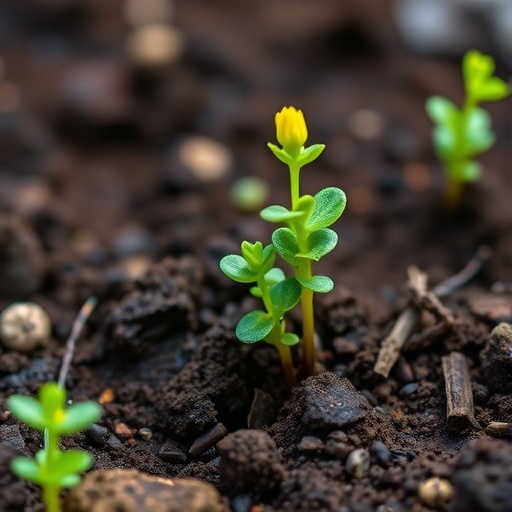In a seminal study poised to reshape our understanding of ecosystems, researchers have uncovered compelling evidence that the functional diversity of soil microbial communities intensifies as ecosystems mature and develop. This breakthrough challenges longstanding assumptions about soil biology and offers vital insights into the dynamic relationships that underpin terrestrial ecosystems worldwide. The study, conducted by a multidisciplinary team led by Sveen, Viketoft, Bengtsson, and colleagues, is slated for publication in the prestigious journal Nature Communications in 2025.
At the heart of this research lies an intricate examination of soil microbial communities—microorganisms inhabiting the vast and complex subterranean networks beneath our feet. These microscopic entities are far from passive; they are crucial drivers of nutrient cycling, organic matter decomposition, and overall soil health. Traditionally, microbial diversity has been studied either in terms of species richness or taxonomy. However, this investigation pushes the envelope by focusing on functional diversity, which relates to the array of biochemical capabilities and ecological roles that microbial populations can fulfill within their environment.
The authors employed state-of-the-art metagenomic and metatranscriptomic techniques to profile microbial communities across multiple stages of ecosystem development, ranging from nascent soil formations to fully mature forest soils. By analyzing the genetic potential and expressed functions of microbial genes, the research team was able to construct a detailed map of microbial functional traits. This approach illuminated not just who was present in the soil, but what roles they might be playing in ecosystem processes.
Results indicated a striking positive correlation between ecosystem maturity and microbial functional diversity. As soil environments evolve and accumulate organic matter, plant root networks expand, and microhabitats diversify, microbial communities similarly broaden their functional repertoire. Such diversification is critical; it suggests that soil microbiomes become increasingly adept at facilitating a variety of biochemical transformations—ranging from nitrogen fixation and phosphorus cycling to the degradation of complex organic molecules—thereby enhancing ecosystem resilience and productivity.
The implications of this research extend beyond basic ecological theory. By elucidating how microbial functional diversity grows alongside ecosystem development, the study provides an essential framework for predicting how ecosystems might respond to environmental stressors such as climate change, pollution, or land use alteration. Given that soil microbial functions directly influence carbon sequestration and greenhouse gas emissions, a more functionally diverse microbiome could denote greater potential for climate mitigation through natural processes.
Moreover, the findings advocate for the inclusion of microbial functional diversity as a key metric in ecosystem monitoring and conservation strategies. Traditional biodiversity assessments have largely overlooked belowground organisms, yet this study underscores their indispensable contribution to ecological stability. Protecting and fostering conditions that enable the expansion of microbial functional traits during ecosystem development could become a priority for land managers and policymakers aiming to sustain ecosystem services.
The authors also delve into the mechanisms driving the increase in microbial functional diversity, highlighting the role of spatial heterogeneity and resource gradients within soils. As ecosystems develop, heterogeneous microenvironments emerge, fostering niche differentiation among microbes. This niche partitioning reduces competition and encourages coexistence of functionally distinct taxa, thereby boosting overall community functionality. This insight elegantly links ecosystem structural complexity with microbial ecology, suggesting a feedback loop where aboveground and belowground diversity promote each other.
To achieve these insights, the research incorporated longitudinal sampling designs and leveraged cutting-edge computational models to parse complex datasets. This integrative approach allowed for robust statistical associations between ecosystem age, soil chemical properties, and microbial functions. Such methodological rigor affirms the credibility of the conclusions while setting a benchmark for future investigations in soil microbial ecology.
The study’s interdisciplinary nature underscores the evolving landscape of ecological research. Collaboration between soil scientists, microbiologists, bioinformaticians, and ecologists was pivotal in unpacking the multifaceted relationships studied. This exemplifies a growing trend toward convergence science to tackle pressing environmental questions, which is becoming increasingly necessary in the face of rapidly changing global ecosystems.
Interestingly, the research also touches upon how anthropogenic influences might disrupt these natural trajectories of microbial functional diversification. Land disturbances that simplify soil structure or reduce organic inputs could potentially truncate the development of functionally diverse microbial communities. This has concerning implications for the sustainability of managed ecosystems and the recovery of degraded lands, emphasizing the need for restoration practices attentive to microbial functional dynamics.
The authors conclude by calling for further research to explore causal mechanisms through experimental manipulations, such as controlled soil amendments or simulated succession models. Understanding how specific environmental factors modulate microbial functional diversity could unlock new possibilities for ecosystem management tailored to leverage microbial capabilities for ecosystem restoration and climate adaptation.
Overall, this pathbreaking research reaffirms the immense yet often overlooked importance of soil microbial communities as engines of ecosystem health and development. Their increasing functional diversity with ecosystem maturity not only deepens scientific understanding but also paves the way for innovative environmental policies and sustainable land stewardship. As global ecosystems face unprecedented pressures, appreciating and harnessing the functional complexity beneath our feet may be pivotal for securing a resilient future.
The sweeping narrative emerging from Sveen et al.’s work is that ecosystems are more than just collections of plants and animals; they are intricate, living biomes profoundly interconnected from the smallest microbes to the tallest trees. Recognizing soil microbes as integral architects and caretakers of ecosystems invites a paradigm shift in how we perceive biodiversity, conservation, and our relationship with the natural world.
With this knowledge, science moves closer to decoding the hidden functioning of Earth’s critical interfaces and better equipping humanity to protect and recreate environments that thrive sustainably. The functional diversity of soil microbes, once an esoteric ecological detail, now takes center stage as a fundamental determinant of ecosystem robustness and evolutionary potential.
Subject of Research: Soil microbial functional diversity and its relationship to ecosystem development.
Article Title: Functional diversity of soil microbial communities increases with ecosystem development.
Article References:
Sveen, T.R., Viketoft, M., Bengtsson, J. et al. Functional diversity of soil microbial communities increases with ecosystem development. Nat Commun (2025). https://doi.org/10.1038/s41467-025-66544-8
Image Credits: AI Generated




